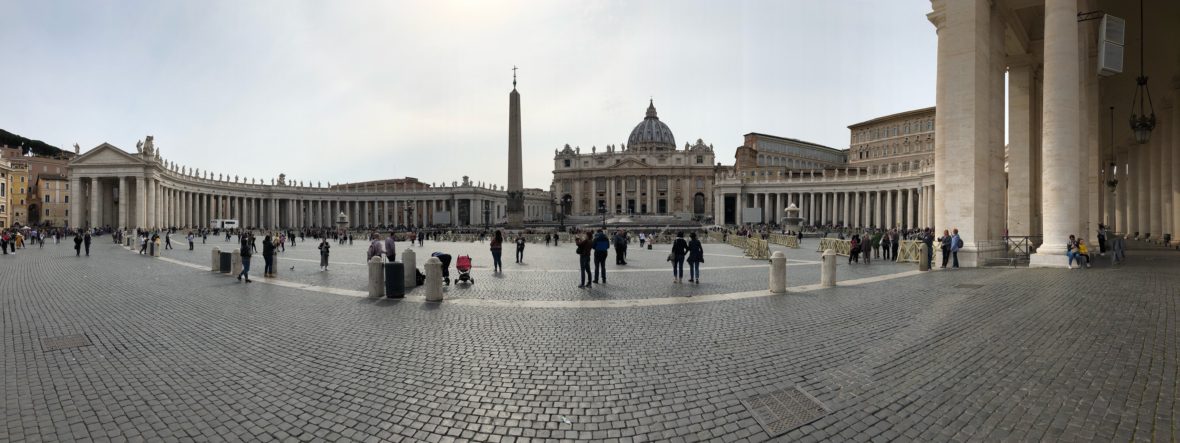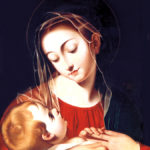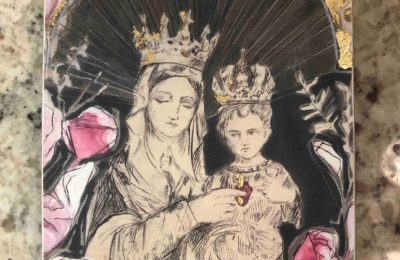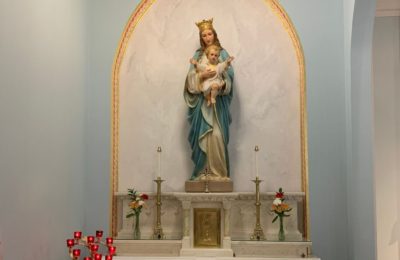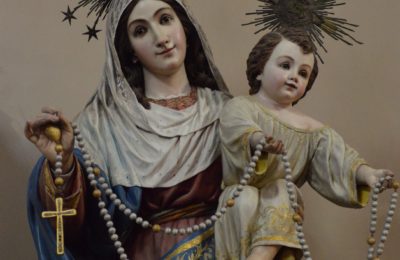“Tuesday, October 11th- Went to the Vatican and saw Mr. Bisleti, Master of the Chambers, who gave us a ticket for the papal audience, and then inspected the Sistine Chapel decorated with grand frescoes by Michelangelo, which were so old and defaced that they were very disappointing to us (the frescoes have been refreshed since this writing, between 1980-1999, added by SCF). In the afternoon, went in full dress to the audience where we found many persons in several magnificent rooms and waited about 3/4 hour in great trepidation. When the Pope (Pius X, added by SCF) came in with a few attendants all in white he presented a noble appearance but (was) so genial and simple that all fear was dissipated. We all knelt down and he walked around giving us his hand to kiss which I pressed asking his blessing for my dear wife and children. He smiled and spoke to me affectingly.” ~ E. Francis Baldwin, travel diary, 1904
A couple of days ago, I received the (above) panoramic view of St. Peter’s Square in Vatican City from one of The Marian Room contributors, R. Anne, who is visiting Rome with her family. It caused me to think about the beautiful Catholic churches of Rome, and the beauty of this famous square. I remembered the times I had stepped across the historic square, and recalled reading of the time in 1904 that my great-grandfather did, as well.
I recently re-read the travel diary that my American Roman Catholic architect great-grandfather, E. Francis Baldwin, kept when he made a pilgrimage to Rome in 1904 (excerpt, above). He was in Italy to witness his son’s priestly ordination, and to receive a papal award for contributions he had made to sacred architecture; and for such reasons, he had the honor of being received by Pope Saint Pius X. But, despite this honor, the standout points of the diary are his notes on the grandeur of the squares and churches he visited. He loved traditional Catholic architectural beauty, and went about the city recording details on the churches he visited. Which might lead us to ask: why did the standards of Catholic church architecture decline in the 1960’s to such an extent that we ended up with round churches, bare altars, plain walls, and childish stained glass windows (choppy figures without faces); churches devoid of beauty and charm?
The beauty of a church leads man to contemplate the beauty of God.
Art and beauty reminds us of what we have forgotten (GKC).
Could the Masonic-Protestant look of the new modern churches have anything to do with a decline in church attendance, and a bleeding out of Catholics from the pews? Who wants to go to an ugly church every week? I do not, and will make every effort to avoid these modern buildings which resemble spaceships. If that was part of the “liturgical revolution,” I say, let us counter that revolution with a return to beautiful church architecture.
One hundred years from now, I do not think anyone will travel across the world to view a hollowed out church in the round in an American suburb. However, they will go to great efforts to walk across Bernini’s St. Peter’s square, and enter the grand basilica of the same name; as my great-grandfather did in 1904, as I did on three separate pilgrimages in the later 20th century, and into the 21st century; as R. Anne is now doing.
Beauty stands the test of time.
We see that.
May we not forget.
Hail Tradition!
Hail Beauty!
~SCF
~Additional information: the following is a bit of the history of St. Peter’s Square:
Designed and built by Bernini between 1656 and 1667, during the pontificate of Alexander VII (1655-1667), the square is made up of two different areas. The first has a trapezoid shape, marked off by two straight closed and convergent arms on each side of the church square. The second area is elliptical and is surrounded by the two hemicycles of a four-row colonnade, because, as Bernini said, “considering that Saint Peter’s is almost the matrix of all the churches, its portico had to give an open-armed, maternal welcome to all Catholics, confirming their faith; to heretics, reconciling them with the Church; and to the infidels, enlightening them about the true faith.” Bernini had in fact designed a three-armed portico, but after Alexander VII’s death, construction of the portico was halted, and the third arm was never built. It would have enclosed the whole building and separated the ellipse from the “Borgo” quarter, thus creating a “surprise effect” for the pilgrim who suddenly found himself in the square. This effect was somewhat achieved by the buildings surrounding the square, the so-called “Spina di Borgo”, which naturally “closed in” the square. In 1950, Via della Conciliazione, a new, wide street leading to the Vatican Basilica, was opened. It amplifies the majestic view of Saint Peter’s dome, but it also profoundly modified Bernini’s original plan. The measurements of the square are impressive: it is 320 m deep, its diameter is 240 m and it is surrounded by 284 columns, set out in rows of four, and 88 pilasters. Around the year 1670, Bernini’s pupils built 140 statues of saints, 3.20 m high along the balustrade above the columns. On either side of the obelisk, which was moved to the middle of the square by Domenico Fontana in 1585, are two great fountains built by Bernini (1675) and Maderno (1614). Below, at the foot of the staircase in front of the basilica, the statues of Saint Peter and Saint Paul seem to welcome visitors… (source)
There are one hundred and forty saints statues on the colonnades. A chart which identifies the saints may be seen here.

